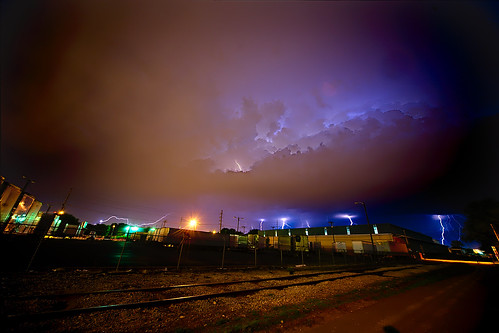lightning tips
27 May 2011
I had someone ask me for tips regarding lightning photography and it got long enough I figured I may as well post it here and just link to it. These are just some random things I’ve had success with. Your mileage may vary:
The general idea for capturing lightning is to take longer exposures in which you happen to catch the bolts in the frame. I usually use anywhere from 5 seconds to 30 seconds, depending on how much lightning there is and what effect I desire – a 30 second exposure will have much more blurred/fluid cloud movement as opposed to a 5 second exposure which would have more cloud definition)..
Either way, a longer exposure is necessary, as no human has the reflexes to catch a lightning bolt. However, a long exposure of a scene metered normally may be blown out subsequently if you get a really brilliant lightning flash, so you may have to underexpose severely so that when you do get lightning, it’s not blown out..
So, a few tips:
- Use Av or Tv to meter the scene and get a feel for a ‘normal’ exposure of foreground and sky..
- Switch to Manual to use those settings to dial in a proper exposure for the lightning (probably a bit underexposed, but it depends on the lighting situation) so that it will not be overexposed. From there you can quickly adjust what you want specifically to respond to what you want or changing conditions. (You’d be surprised how often the lighting in a storm changes depending on whether there are high clouds or low-hanging clouds reflecting city light moving in, etc). Whether and how much you underexpose will vary depending on conditions. If the storm and the lightning are far away, you can probably get away with just metering normally, because the distant bolts will not cause much ambient reflection that might blow out the scene. If the storm is right on top of you, though, you may have to underexpose more, because a large nearby brilliant flash is going to be very bright.
- If your camera has Long Exposure Noise Reduction (most modern DSLRs do), turn it off – in Canon cameras, it’s in Custom Functions. I do this because when you are trying to get lightning, murphy’s law will dictate that you *will* see the most spectacular bolts while you are doing something else – or waiting for your camera before taking another exposure. When the camera notices you are doing a long exposure, it immediately takes a dark frame exposure right afterwards and subtracts it in order to eliminate noise. This is a great feature, but it means if you take a 30 second exposure, your camera will spend another 30 seconds taking the dark frame, and during this time I guarantee you will see all the most spectacular stuff. So, I turn that off and just snap away over and over. The unfortunate consequence is that your resulting pictures will have a lot more defects: noise, in the form of “stuck” or dead pixels from your sensor that will need to be fixed in post-processing. It’s tedious, but not that hard to do in GIMP or Photoshop. The newer the camera you have, the less this will be an issue. (It takes me forever with my ancient 5D)
- Once you have the metering situation sorted out, you get to the boring part: sitting there pressing the shutter button over and over until it starts to rain. Don’t bother spending much time reviewing your pictures to see what you’ve got – you’ll miss something spectacular while you’re peering at the LCD. Let it be a surprise when you get home.
- Lightning is unpredictable, naturally, so a wider angle lens can be helpful to guarantee you get lightning in the frame. You can get different/cooler results using a tighter lens focused on a particular part of the sky, but obviously this requires a lot more patience and luck.
- Composites (combinations of multiple shots) are your friend. Sometimes you get a few bolts here and there that are unremarkable alone, but can look pretty cool when combined into one exposure. It’s a lie, but so is all photography. Compositing is not trivial, but it’s not terribly difficult. Look up tools like Hugin’s “enfuse” for a starting point on how to accomplish this. The above shot is a composite of a bunch of photos from an oncoming storm.
- Try not to get hit by lightning, as I understand it really sucks.